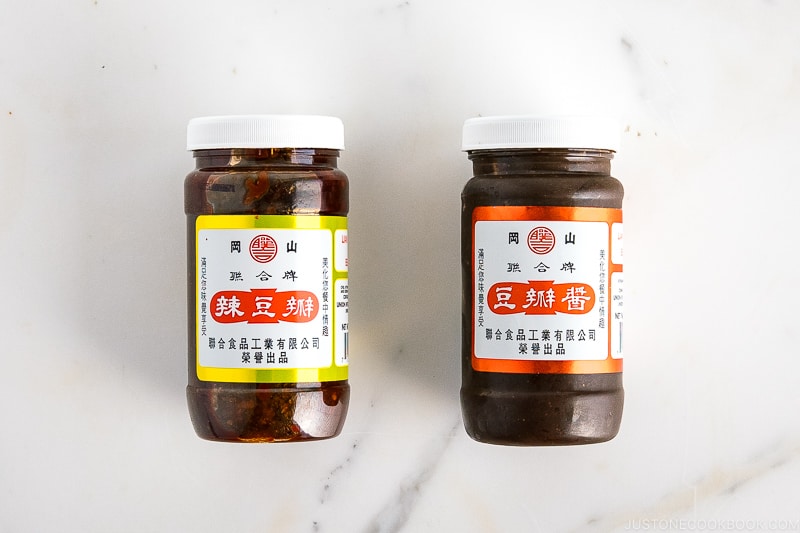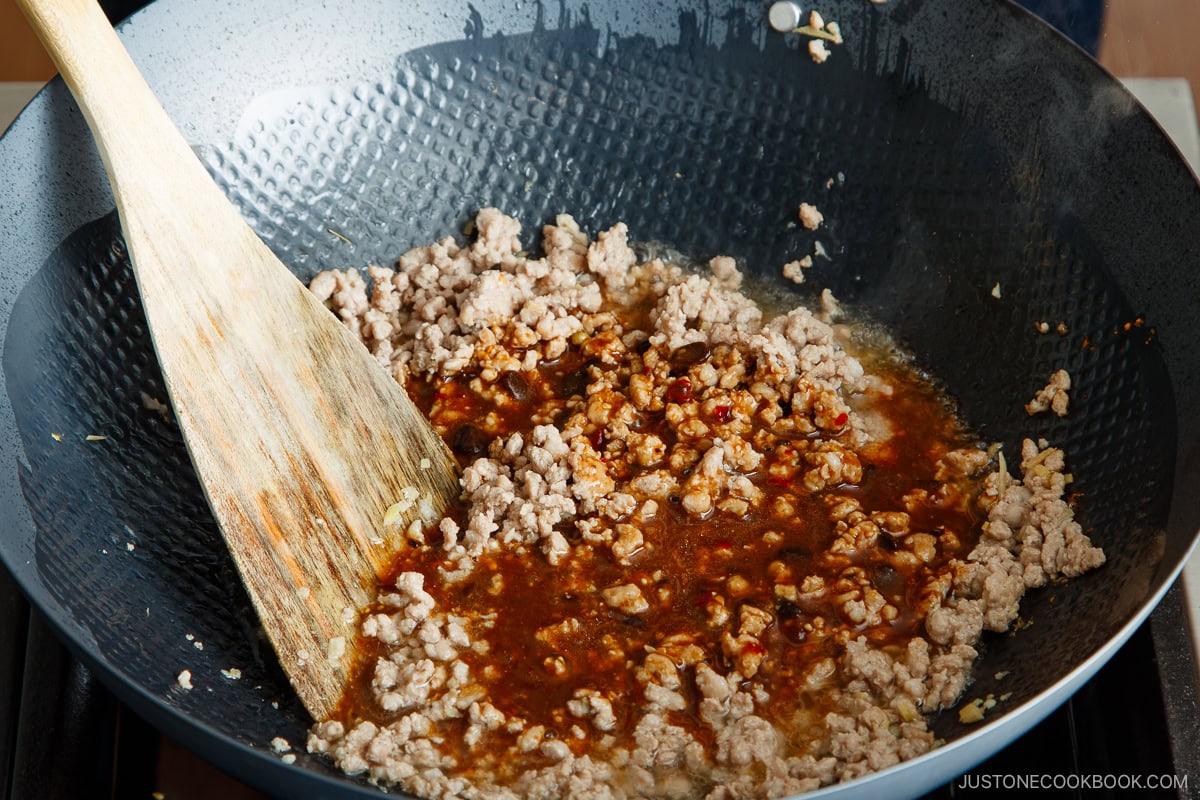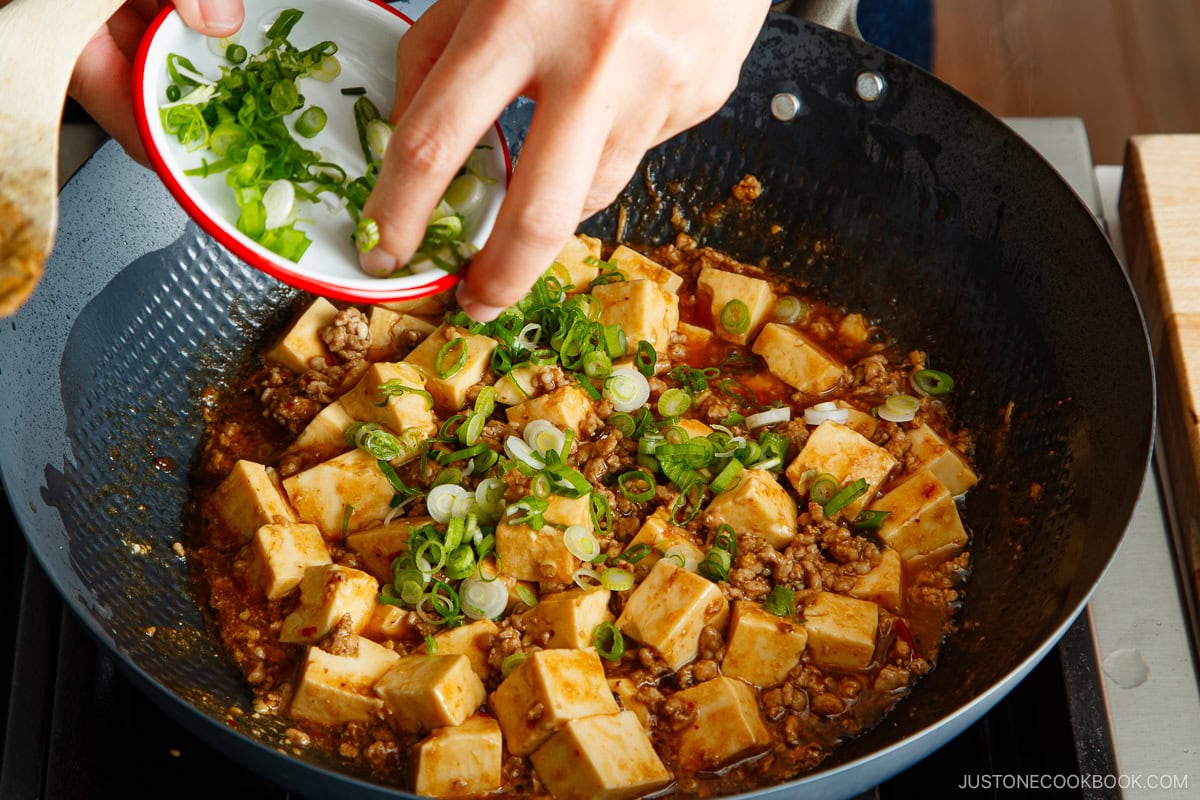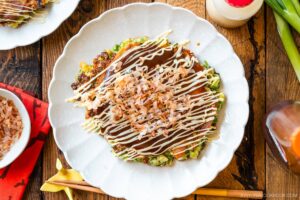Japanese-style Mapo Tofu (Mabo Dofu) is full of flavor but much less spicy than the original Sichuan dish. Even kids can enjoy this family-friendly recipe of ground pork and silken tofu that’s ready in just 30 minutes! {Vegetarian/Vegan Adaptable}
Comforting and full of umami, Japanese-style Mapo Tofu (麻婆豆腐) is easily one of my family’s favorite meals! It is so simple to make, and I love cooking this dish on a hectic weeknight when I have just 30 minutes to spare. I’ll teach you how to make this delicious recipe and serve it either rice-bowl style over fluffy steamed rice or as the main dish in a dinner set.
If you love the Japanese adaptation of Chinese cuisine called Chuka ryori, try my Gyoza, Tan Tan Men, and Japanese Fried Rice recipes next!
What is Mapo Tofu?
Called mabo dofu (麻婆豆腐,マーボー豆腐) in Japanese, mapo tofu was popularized in the 1970s by Chinese-Japanese Chef Chen Kenmin (陳建民) through his Chinese restaurant Shisen Hanten. There, he adapted this dish to suit milder Japanese tastes by notably omitting fiery-red chili and Sichuan peppercorn from the sauce. Thanks to Chef Chen, you’ll find many Chinese-style dishes like mapo tofu, Ebi Chili (Chili prawns エビチリ), and Beef and Bell Pepper Stir-fry (chin-jao ro-su, 青椒肉絲) in Japan’s home-cooking repertoire.

Why I Love This Recipe
- Perfect for a weeknight dinner – This recipe is ready in just 30 minutes. It’s a lifesaver when I want to get a nutritious and comforting meal on the table but don’t have a lot of time.
- Hearty and healthy! I love that it’s delicious, healthy, and packed with protein. It’s a dish that I feel good feeding my family.
- Family-friendly – The mild heat/spice level means that even children can enjoy eating this dish. I cooked it for my kids from the time they were very young and they love it to this day!
- Easily customizable – Make it less or more spicy, change the ground meat, or make it vegetarian/vegan. I’ll suggest below how to adapt this dish to suit your needs.

Ingredients for Mapo Tofu
Japanese-style mapo tofu is a very easy dish. This was one of the first recipes my son learned to cook over the summer break as a teen, and now he makes it for himself in college!
- Soft/silken tofu (kinugoshi dofu)
- Ground pork
- Garlic
- Ginger
- Green onions/scallions
- Neutral oil
- Sauce:
- Doubanjiang (spicy or non-spicy broad bean paste) – This fermented seasoning adds an authentic and deeply savory character. Without it, the dish won’t taste the same.
- Oyster sauce
- Miso – unique to Japanese-style mapo tofu
- Soy sauce
- Mirin – unique to Japanese-style mapo tofu
- Toasted sesame oil
- Potato starch or cornstarch
- Water
- Japanese sansho pepper (optional, for serving)
Find the printable recipe with measurements below.
Jump to Recipe
Substitutions
- Silken Tofu: I highly recommend using soft/silken tofu since it adds a smooth and creamy texture to the dish. However, you could use medium tofu if that’s what you have. Please drain the tofu for 15–30 minutes before you start cooking.
- Doubanjiang: I personally use the Taiwanese brands Lian How (岡山) or Ming De (明徳), which have a milder heat level. If you can’t find these brands, some people recommend using gochujang (spicy Korean chili paste) or doenjang (non-spicy Korean soybean paste). I haven’t tried them before, but these will alter the flavor profile. For spicy Sichuan doubanjiang, check Amazon or other online Asian markets. You could also use gluten-free doubanjiang for GF.


How to Make Mapo Tofu
Preparation
Step 1 – Prep the ingredients before you start cooking. This dish cooks quickly! I strongly recommend that you measure and mix the sauce ingredients and cut the aromatics and tofu ahead of time so everything is ready to go.


Cooking
Step 2 – Stir-fry the garlic and ginger. Add the garlic and ginger to the hot oil in the preheated wok and sauté until fragrant.

Step 3 – Sauté the ground pork. Add the ground meat to the wok and break up the chunks with a wooden spatula. Cook the meat until it’s no longer pink.

Step 4 – Add the sauce mixture and simmer. Cook and stir until the sauce bubbles and thickens.

Step 5 – Add the tofu and green onions. Coat the tofu with the sauce until the flavors infuse. Then, add the green onions.

Step 6 – Serve. You can serve the mapo tofu on individual dishes as part of a composed meal, or enjoy it donburi-style like I do spooned over a large bowl of steamed rice.

Nami’s Recipe Tips
- Drain the tofu ahead of time for about 15 minutes – This prevents the tofu from releasing moisture into the sauce and diluting it. If you’re like me, you’ll love a savory sauce that’s thick and rich combined with a base of fluffy and steaming hot rice!
- Cut and prepare the ingredients before cooking – This dish cooks fast, and the pan needs constant attention so the ingredients don’t burn. I highly recommend prepping all the ingredients in advance, as there’s no time to step away from the stove once cooking starts. I line up my prepped ingredients next to the stove so I can add them to the pan in quick succession.
- Measure and mix the sauce ingredients ahead of time in a small bowl. I keep the sauce mixture nearby and ready to add to the pan at just the right moment.
- Take care not to burn the garlic and ginger when stir-frying. You don’t want to add a burnt bitter taste to the sauce.
- Carefully stir the tofu – Tofu can easily break and become mushy. Shake the pan to coat the tofu with the sauce, minimizing spatula action.
Variations and Customizations
This mapo tofu recipe is easy to adapt to your preferences and needs. Here are a few of my suggestions for how to vary this delicious dish.
- Change up the ground meat. In Japan, we always use ground pork. However, you can use ground turkey, ground chicken, or ground beef.
- Make it vegetarian/vegan. Instead of meat, use finely diced fresh or dried (rehydrated) shiitake mushrooms. Use vegetarian stir-fry sauce in place of oyster sauce.
- Adjust the heat level. Add more or less doubanjiang, use the Taiwanese non-spicy version, or turn up the heat with a few teaspoons or more of fiery-red Sichuan doubanjiang! For less heat, I recommend using 1½ Tbsp non-spicy doubanjiang and 1 Tbsp spicy la doubanjiang. If you like it slightly spicier, sprinkle la-yu (Japanese chili oil).
- “College-meal” version. My son made this 10 Minute Meal – Mapo Tofu recipe in an electric pot at his dorm kitchen, and his friends loved it! It’s super quick and easy to make.

What to Serve with Mapo Tofu
- As a rice bowl – If you serve it donburi-style (mapo tofu over rice), I suggest adding Homemade Miso Soup and a simple veggie side like Japanese Cucumber Salad to make it a complete meal.
- As the main dish of a traditional ichiju sansai meal – For a Japanese-style “One Soup Three Dishes” meal, serve the rice and mapo tofu in separate dishes, then add a miso soup, two side dishes, and a small dish of Japanese pickles.
Storage and Reheating Tips
To store: Once the mapo tofu is cooled to room temperature, store the leftovers in a glass airtight container in the refrigerator for up to 3 days. I do not recommend freezing this dish as tofu changes its texture once frozen.
To reheat: Gently warm up in a saucepan over medium-low heat until thoroughly heated.
Frequently Asked Questions
Wrap a paper towel around the silken tofu and set it on a plate or tray to drain the moisture for about 15 minutes. Be gentle when handling it since silken tofu is very fragile. Do not press the tofu because it will crumble easily.
More Chuka Ryori Recipes
If you love this Mapo Tofu, you’re in for a treat with these other irresistible Japanese-style Chinese recipes.



Prevent your screen from going dark
-
Gather all the ingredients. Here, I use a combination of non-spicy doubanjiang (dark brown color) and spicy la doubanjiang (deep red color).
-
Combine the sauce ingredients. To a small bowl, add 2½ Tbsp doubanjiang (spicy chili bean paste), 1 Tbsp oyster sauce, 1 Tbsp miso, ½ Tbsp soy sauce, 2 Tbsp mirin, 1 tsp toasted sesame oil, 1 tsp potato starch or cornstarch, and 4 Tbsp water. Mix well together with a whisk.
-
Finely mince 2 cloves garlic (I use a garlic press). Thinly peel off the ginger skin with a sharp knife or scrape it off with a spoon.
-
Cut the ginger into thin slices, then into thin julienne strips. Mince the strips and measure 1 Tbsp ginger.
-
Slice 2 green onions/scallions crosswise into thin rounds. Set aside some for garnish when serving.
-
Drain 14 oz soft/silken tofu (kinugoshi dofu) and cut into ¾-inch (2-cm) cubes.
To Cook the Mapo Tofu
-
Heat a wok or large frying pan on medium heat. Add 1 Tbsp neutral oil to the hot pan. Then, add the garlic and ginger to the hot oil.
-
Sauté the aromatics until fragrant, making sure they don‘t burn. Then, add ½ lb ground pork to the wok.
-
Cook the pork, breaking up the chunks with a spatula or wooden spoon, until the meat is no longer pink.
-
Give the sauce mixture a final stir, then add it to the wok. Stir thoroughly as you bring the sauce to a simmer.
-
Add the tofu and gently coat it with the sauce. Stir frequently, without mashing the tofu, until it is heated through.
-
Add most of the green onions, reserving some for garnish. Stir to incorporate just before taking the pan off the heat.
Calories: 263 kcal · Carbohydrates: 9 g · Protein: 17 g · Fat: 17 g · Saturated Fat: 5 g · Polyunsaturated Fat: 3 g · Monounsaturated Fat: 6 g · Cholesterol: 41 mg · Sodium: 845 mg · Potassium: 395 mg · Fiber: 1 g · Sugar: 4 g · Vitamin A: 180 IU · Vitamin C: 2 mg · Calcium: 55 mg · Iron: 3 mg
Editor’s Note: The post was originally published on January 29, 2011. The video was added to the post on May 6, 2016. The post was updated with new images on February 4, 2024, and republished with more helpful information on December 3, 2024.




